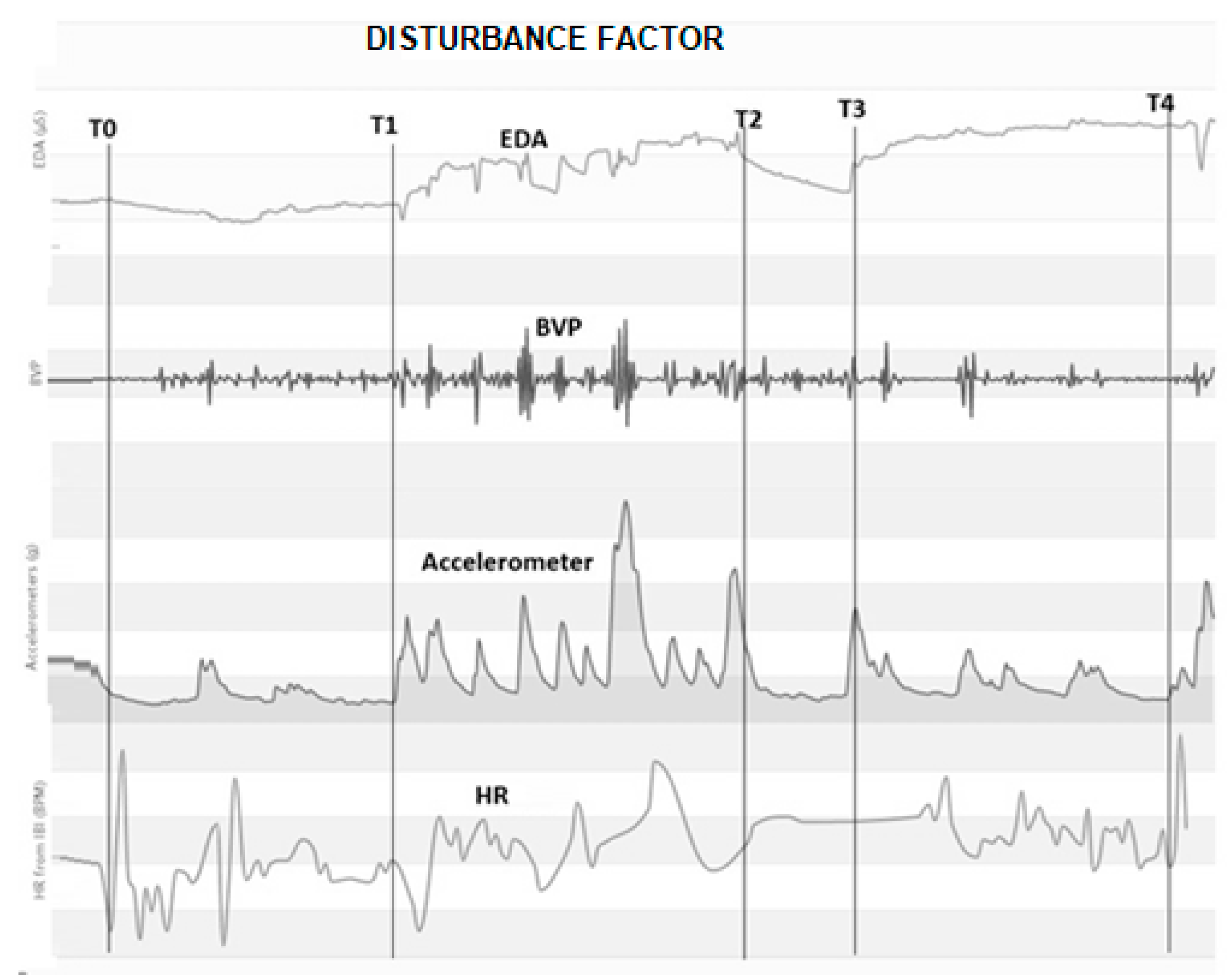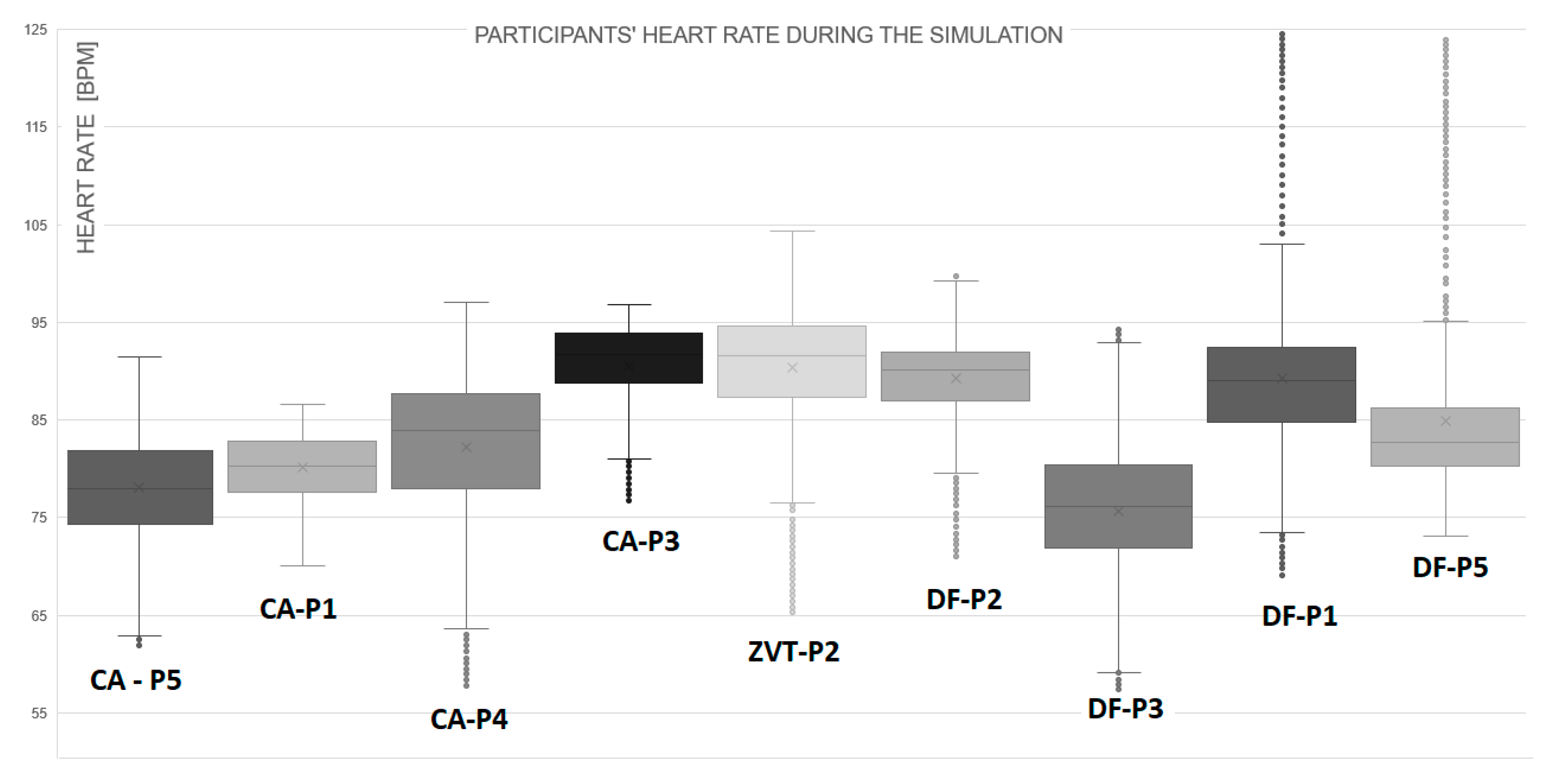Human Factor in Navigation: Overview of Cognitive Load Measurement during Simulated Navigational Tasks
Abstract
1. Introduction
2. Materials and Methods
2.1. Related Work
2.2. The Current Experiment
2.3. Raw Data Sampling
3. Results
3.1. Experimental Procedure
3.2. Results
3.3. Post Processing and Data Visualization
4. Discussion
5. Conclusions
Author Contributions
Funding
Acknowledgments
Conflicts of Interest
References
- Hareide, O.S.; Ostnes, R. Maritime Usability Study by Analysing Eye Tracking Data. J. Navig. 2016, 70, 927–943. [Google Scholar] [CrossRef]
- Miklody, D.; Moessmer, P.; Dettmann, T.; Klinkenberg, K.; Blankertz, B. Multi-timescale spectra as features for continuous workload estimation in realistic settings. In Proceedings of the 7th Graz Brain-Computer Interface Conference, Graz, Steiermark, Austria, 18–22 September 2017. [Google Scholar] [CrossRef]
- Bertram, V.; Plowman, T. A Hitchhiker’s Guide to the Galaxy of Maritime e-Learning. In Proceedings of the 2019 18th COMPIT Conference Proceedings, Rostov-on-Don, Russia, 20–21 September 2019; pp. 7–23, ISBN 978-3-89220-709-2. [Google Scholar]
- Miklody, D.; Uitterhoeve, W.; Van Heel, D.; Klinkenberg, K.; Blankertz, B. Maritime Cognitive Workload Assessment; Symbiotic Interaction; Springer International Publishing: Berlin/Heidelberg, Germany, 2017; pp. 102–114. [Google Scholar]
- EMSA Annual Overview of Marine Casualties and Incidents 2019. Available online: http://www.emsa.europa.eu/news-a-press-centre/external-news/item/3734-annual-overview-of-marine-casualties-and-incidents-2019.html (accessed on 22 December 2019).
- Perkovič, M.; Gucma, L.; Bilewski, M.; Muczynski, B.; Luin, B.; Vidmar, P.; Lorenčič, V.; Batista, M. Laser-Based Aid Systems for Berthing and Docking. J. Mar. Sci. Eng. 2020, 8, 346. [Google Scholar] [CrossRef]
- Sumpor, D. Relevant Factors of Driver Reaction Time for Cognitive Motoric Tasks; Fakultet Prometnih Znanosti: Zagreb, Croatia, 2019. [Google Scholar]
- Main, L.C.; Wolkow, A.; Chambers, T.P. Quantifying the Physiological Stress Response to Simulated Maritime Pilotage Tasks: The Influence of Task Complexity and Pilot Experience. J. Occup. Environ. Med. 2017, 59, 1078. [Google Scholar] [CrossRef] [PubMed][Green Version]
- Kim, H.; Kim, H.J. Collision Scenario-based Cognitive Performance Assessment for Marine Officers, 2010. Trans. Navig. Int. J. 2010, 4, 73–77. [Google Scholar]
- Haberlandt, K. Cognitive Psychology; Allyn & Bacon: Boston, MA, USA, 1997; ISBN -13 9780205139392. [Google Scholar]
- Merchant Shipping. Safe Manning, Hours of Work and Watchkeeping. In SOLAS Regulations; SOLAS: Haven, CT, USA, 1997. [Google Scholar]
- Maritime Labour Convention. Consolidated Text Established by the International Labour Office, Including the Amendments of 2014 and 2016 to the Code of the Convention; Maritime Labour Convention: Geneva, Switzerland, 2006. [Google Scholar]
- Work Hours and Rest Hours on Ships (Including STCW 2010 and Merchant Shipping (Safe Manning, Hours of Work and Watchkeeping); Regulations: 1997); SOLAS: Haven, CT, USA, 1997.
- Barnett, M.L. Searching for the Root Causes of the Maritime Casualties (2005). WMU J. Marit. Aff. 2005, 4, 131–145. [Google Scholar] [CrossRef]
- Fridman, L.; Reimer, B.; Mehler, B.; Freeman, W.T. Cognitive Load Estimation in the Wild (2018). In Proceedings of the 2018 CHI Conference on Human Factors in Computing Systems, Montreal, CQ, Canada, 21–26 April 2018; p. 652. [Google Scholar]
- Liu, Y.; Lim, W.L.; Subramaniam, S.C.H.; Liew, S.H.P.; Krishnan GSourina, O.; Konovessis, D.; Ang, H.E.; Wang, L. EEG-based Mental Workload and Stress Recognition of Crew Members in Maritime Virtual Simulator: A Case Study. In Proceedings of the International Conference on Cyberworlds (CW), Chester, UK, 20–22 September 2017. [Google Scholar]
- Saus, E.R.; Johnsen, B.H.; Eid, J.; Thayer, J.F. Who benefits from simulator training in relation to situation awareness during navigation training: Personality and heart rate variability. Comput. Hum. Behav. 2012, 28, 1262–1268. [Google Scholar] [CrossRef]
- Orlandi, L.; Brooks, B. Measuring mental workload and physiological reactions in marine pilots: Building bridges towards redlines of performance. Appl. Ergon. 2018, 69, 74–92. [Google Scholar] [CrossRef] [PubMed]
- Kim, H.; Yang, C.S.; Lee, B.W.; Young, Y.H.; Hong, S.K. Alcohol effects on navigational ability using ship handling simulator. Int. J. Ind. Ergon. 2007, 37, 733–743. [Google Scholar] [CrossRef]
- Di Nocera, F.; Mastrangelo, S.; Baldauf, M.; Steinhage, A.; Kataria, A.; Proietta, S. Mental workload assessment using eye-tracking glasses in a simulated maritime scenario. In Proceedings of the HFESE, Groningen, The Netherlands, 14–16 October 2015; pp. 235–248. [Google Scholar]
- Arenius, M.; Athanassiou, G.; Sträter, O. Systemic assessment of the effect of mental stress and strain on performance in a maritime ship-handling simulator. IFAC 2010, 43, 43–46. [Google Scholar] [CrossRef]
- Vidmar, P.; Perkovič, M. Safety assessment of crude oil tankers. Saf. Sci. 2018, 105, 78–191. [Google Scholar] [CrossRef]
- Vidmar, P.; Perkovič, M. Methodological approach for safety assessment of cruise ship in port. Saf. Sci. 2015, 80, 189–200. [Google Scholar] [CrossRef]
- Maglić, L.; Zec, D. The Impact of Bridge Alerts on Navigating Officers. J. Navig. 2020, 73, 421–432. [Google Scholar] [CrossRef]
- Maglić, L.; Valcic, S.; Gundić, A.; Maglic, L. Voice Communication Systems Impact on Navigating officers. MDPI, Journal of Marine Science and Engineering. J. Mar. Sci. Eng. 2020, 8, 197. [Google Scholar] [CrossRef]






| Direct Approach | Indirect Approach |
|---|---|
| Brain waves intensity (EEG) | Heart rate |
| Stress hormone rate (Cortisol) | Electro-Dermal Activity |
| - | Pupil diameter Electrocardiogram (ECG) |
| - | Body acceleration |
| PAPER | Main 2018 | Liu 2017 | Miklody 2017 |
|---|---|---|---|
| Environment | Simulator | Simulator | Simulator |
| Task | Maneuvering | Overtaking | Maneuvering |
| Aim | Stress | Emotions | Workload |
| Sensor | Cortisol | EEG | EEG |
| Questionnaire | Nasa TLX | Profile | Profile |
| Statistical tool | ANOVA | - | - |
| Processing raw data | - | Support vector ML | Spectral decompositions ML |
| Reason for cognitive load | Weather | Traffic | Weather, n-back test |
| PAPER | Kim 2005 | DiNocera 2015 | Hareide 2019 | Fredman 2018 |
| Environment | Simulator | Simulator | Navy Ship | On-Road |
| Task | Awareness | Navigation | High speed | Car driving |
| Aim | Decision-time | Workload | Visual attention | Workload |
| Sensor | Timer | Eye-tracker | Eye-tracker | Camera |
| Questionnaire | Profile | Nasa-TLX | Profile | Profile |
| Statistical tool | t-test | ANOVA | Average | Classifier |
| Processing raw data | Custom SW | Toby-Studio | TobyPro2 | ConvNet |
| Reason for cognitive load | Traffic | Traffic | High speed | n-back test |
| PAPER | Saus 2012 | Orlandi 2018 | Kim 2007 | Arenius 2010 |
| Environment | Simulator | Simulator | Simulator | Simulator |
| Task | Navigation | Berthing | Navigation | Navigation |
| Aim | Awareness | Workload | Performance | Human error |
| Sensor | ECG | EEG, ECG | ECG | Eye-tracker |
| Questionnaire | Personality test | NASA TLX | NASA-TLX | Interview |
| Statistical tool | Regression | ANOVA | - | - |
| Processing raw data | rMSSD *, Interplt. * | MatLab | t-test | - |
| Reason for Cog. load | Traffic | Familiarity | Alcohol | Emotions |
| Type of Parameter | Manufacturer | Sampling Rate |
|---|---|---|
| PUPIL DIAMETER (mm) | PUPIL CORE | 200 Hz |
| EDA (μS) | EMPATICA | 4 Hz |
| BVP | EMPATICA | 64 Hz |
| SHIPS’ PARAMETERS | WäRTSILä | 10 Hz |
| HEART RATE (BPM) | EMPATICA | 1 Hz |
| ACCELERATION (m/s2) | EMPATICA | 32 Hz |
| TEMPERATURE (°C) | EMPATICA | 4 Hz |
© 2020 by the authors. Licensee MDPI, Basel, Switzerland. This article is an open access article distributed under the terms and conditions of the Creative Commons Attribution (CC BY) license (http://creativecommons.org/licenses/by/4.0/).
Share and Cite
Žagar, D.; Svetina, M.; Košir, A.; Dimc, F. Human Factor in Navigation: Overview of Cognitive Load Measurement during Simulated Navigational Tasks. J. Mar. Sci. Eng. 2020, 8, 775. https://doi.org/10.3390/jmse8100775
Žagar D, Svetina M, Košir A, Dimc F. Human Factor in Navigation: Overview of Cognitive Load Measurement during Simulated Navigational Tasks. Journal of Marine Science and Engineering. 2020; 8(10):775. https://doi.org/10.3390/jmse8100775
Chicago/Turabian StyleŽagar, Dejan, Matija Svetina, Andrej Košir, and Franc Dimc. 2020. "Human Factor in Navigation: Overview of Cognitive Load Measurement during Simulated Navigational Tasks" Journal of Marine Science and Engineering 8, no. 10: 775. https://doi.org/10.3390/jmse8100775
APA StyleŽagar, D., Svetina, M., Košir, A., & Dimc, F. (2020). Human Factor in Navigation: Overview of Cognitive Load Measurement during Simulated Navigational Tasks. Journal of Marine Science and Engineering, 8(10), 775. https://doi.org/10.3390/jmse8100775






